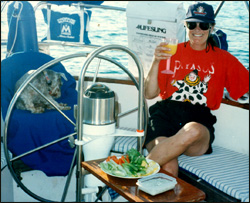Mary Heckrotte
 |
Mary ready for a CAMRYKA Happy Hour |
Since 1992, Mary and husband Carl have drifted mostly in the southern and
western areas of the Caribbean, first on Mariah, a Westerly 36, and then on
Camryka, a Pan Oceanic 46. They were accompanied by Tashi for many years and
now by Mandy, both Miniature Schnauzers who have excelled in the job of
ship's Chief Security Officer. Although far from finished with cruising,
Mary and Carl recently claimed Bocas del Toro, Panama as home ground and
built a small house where cruising friends are readily welcomed for potluck
on the porch.
Mary has been a frequent contributor to sailing publications
including Living Aboard, Caribbean Compass (especially the cooking column "Whacha Gonna Do With All That ...?"), the latest SSCA Cookbook, Cruising
World, and Latitudes and Attitudes. Mary also is a contributor to Gwen's
Hamlin's "Admiral's Angle".
Boat
Camryka is a 1983 Pan Oceanic 46' Pilothouse Cutter (A Ted Brewer design) built in the Philippines and outfitted in the US. In her early years she flitted from marina to marina on the Chesapeake Bay. They bought her when she was 12 years old and turned her into a bluewater-ready lady. She got all new standing rigging and chain plates, solar panels, a wind generator, SSB, radar, a second self steering gear, cruising sails, yachta, yachta, yachta.
Cruising grounds
Mary and Carl have rattled like a loose marble about the Caribbean Basin since 1992. They've spent most of that time in the southern Caribbean (Trinidad, Grenada, Venezuela, Curacao) and the western Caribbean (Guatemala, Honduras, and Panama.)
Although far from finished with cruising, Mary and Carl recently claimed Bocas del Toro, Panama as home ground and built a small house where cruising friends are readily welcomed for potluck on the porch. They are now cruising part time.
Links
Mary Heckrotte also contributed to our article "Refitting the Galley: 12 Experiences": you can read what she had to say here.
[February 2009]